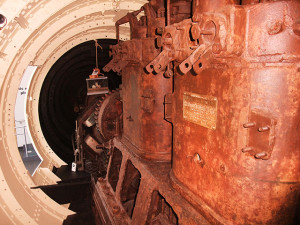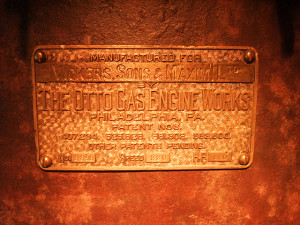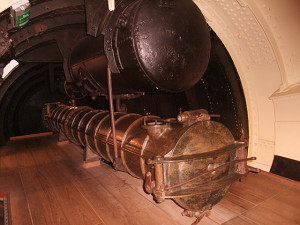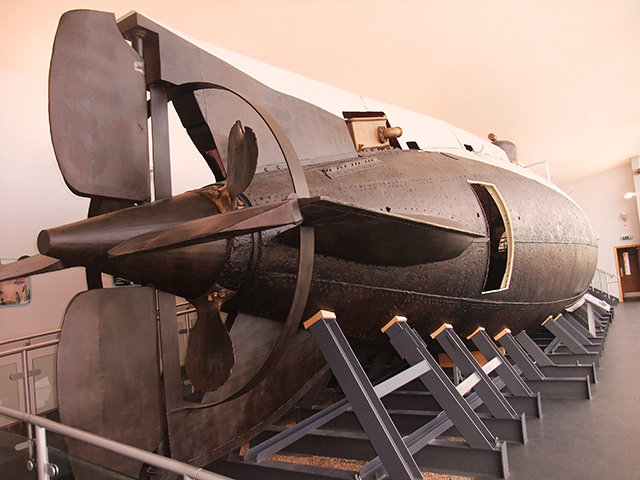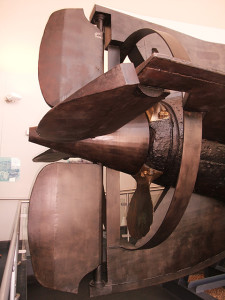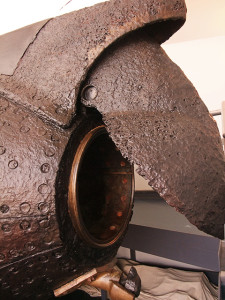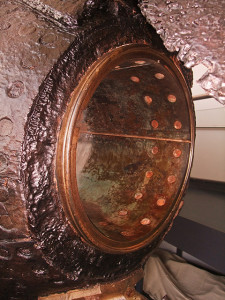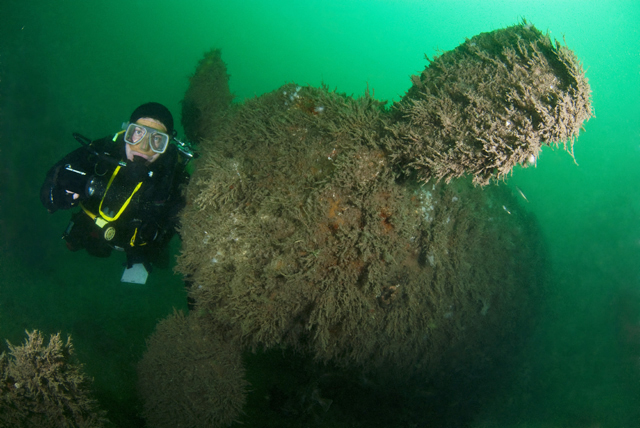News
Hoist the Jolly Roger: Diving the wreck of the Holland 5
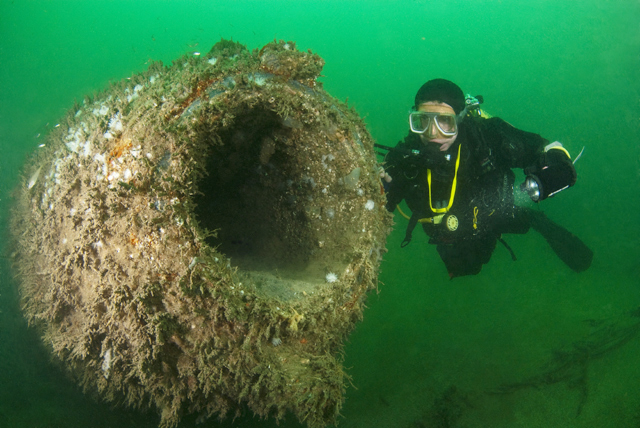
In 1901 Admiral Sir Arthur Wilson, Controller of the Royal Navy, stated ‘Submarines are underhand, unfair and damned un-English. The crews of all Submarines should be treated as Pirates and hanged’. Soon afterwards it became a tradition that British Submarines would hoist the Jolly Roger when returning from successful missions.
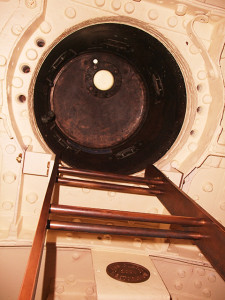 I rang Mark Beattie-Edwards, the Programme Director of the Nautical Archaeology Society, just after 7:00pm as prompted on the instruction sheet he had sent me. I had packed my car and primed my alarm clock in readiness for a 4:00am departure the very next morning. I had even made myself a Corned Beef and Tomato sandwich for the journey. 3 days worth of unsettled weather meant I was still frustratingly waiting to find out was happening. Mark had already checked the weather forecast and the decision had finally been made – we were good to go!
I rang Mark Beattie-Edwards, the Programme Director of the Nautical Archaeology Society, just after 7:00pm as prompted on the instruction sheet he had sent me. I had packed my car and primed my alarm clock in readiness for a 4:00am departure the very next morning. I had even made myself a Corned Beef and Tomato sandwich for the journey. 3 days worth of unsettled weather meant I was still frustratingly waiting to find out was happening. Mark had already checked the weather forecast and the decision had finally been made – we were good to go!
I had been invited along on a NAS outing to dive the ‘mother of all Subs’ aka the Holland 5 Submarine wreck located 6 miles off the Sussex coast near Eastbourne. When I first received the e-mail I had no idea what the Holland 5 really was. After a quick internet search I discovered that the Holland Class Submarines were the first ever Submarines to be commissioned by the Royal Navy back in 1901. From the initial order of 5 Submarines only 2 still remained. Holland 5 is the only surviving example left on the seabed. Holland 1 was salvaged in 1982 and after some extensive restoration now resides at the Submarine Museum in Gosport.
When I arrived at the Sovereign Harbour the sun was shining and the sea conditions looked quite favourable for a change. I had no idea what to expect and with the wreck being more than a 100 years old I didn’t really expect to find much of it left. Mark had chartered DIVE125 jointly skippered by Dave Ronnan and Sylvia Pryer. Dave and Sylvia’s 42 foot custom built boat was roomy enough for 12 divers including all sorts of kit configurations including a new prototype Belgian made Rebreather. All NAS outings are covered by current HSE guidelines so divers have to wear an alternative/redundant air supply in the form of a Pony Cylinder or a Twinset. The plan was to do the first dive on the Holland 5 and then a second shallower dive on the Norman’s Bay wreck. DIVE125 had an onboard compressor for anyone requiring a refill.
The Holland Class was designed by John Philip Holland of Irish-American decent. The first Submarine came off the production line on October 2nd 1901. Each Submarine took around 8 months to build and cost £35,000. There was no launching ceremony as the Submarines were deemed experimental and the Navy were trying to keep their new weapon a secret.
The 19.5 metre long Submarines had a maximum range of 20 miles underwater and a top speed of 7 knots. They could even dive to 30 metres. Capt Bacon, who was in charge of operations, is reported to have said ‘these Submarines would be a terror to any ship’. Initial trials showed that the Submarines could get within 1000 yards of their target without any alarm being raised. A pay load of up to 3 x 18 inch Torpedoes would cause some serious damage to enemy shipping.
The Submarines were never used in ‘active’ service. The Dogger Bank incident in October 1905 was the closest that they ever got to firing a Torpedo at a live target. This involved the Russian Fleet mistakenly attacking a number of British fishing trawlers. But the Holland Submarines were recalled back to harbour when the dispute was resolved by diplomatic means. On the 8th August 1912 the now obsolete Holland 5 was being towed to Sheerness in Kent (probably to be scrapped) when she foundered and sank. There was no loss of life.
Mark said that they found Holland 5 in 2000 but its true identity was not confirmed until April 2001. Once the initial survey work had been completed the Submarine was designated under the protection of wrecks act. This basically states that divers are not allowed to explore the wreck site without first obtaining permission from the NAS. Divers don’t have to be underwater Archaeologists or have special qualifications. Any individual diver or club can make a booking. Contact Mark for a list of available dates.
I was impressed how quickly DIVE125 found the little Submarine. Just to make sure the shotline was sitting right next door to the wreck Dave went down the line first to check its position. Mark offered to show me around the mini Submarine and act as ‘model’ for any pictures I might take. We waited until all the other divers had gone into the water before kitting up. With so many divers kicking around on such a small site I didn’t hold out much hope for pictures but I was pleasantly surprised when we reached the seabed at 31 metres. The bottom composition looked more like gravel than fine silt so the underwater visibility topped out at an impressive 8 metres. Maybe the other divers had heeded my request (demand) to be careful with their fin kicks?
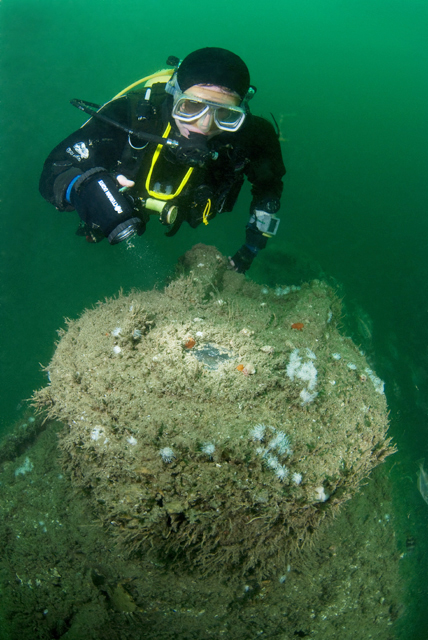 The Submarine was lying upright and looked in remarkably good condition considering its age. Apparently the hull was made from a special high grade metal which has helped to keep it well preserved. Mark finned along the cigar shaped hull to the Conning Tower. I was expecting to see a massive tube like structure sticking out but instead there was a short stubby 1-2 metre ‘tower’ with a hinged hatch on top. A small glass window had been fitted into the centre of the hatch and it was still possible to take a look inside. The Holland Submarines were fitted with one of the first ever periscopes but I couldn’t find anything that resembled one.
The Submarine was lying upright and looked in remarkably good condition considering its age. Apparently the hull was made from a special high grade metal which has helped to keep it well preserved. Mark finned along the cigar shaped hull to the Conning Tower. I was expecting to see a massive tube like structure sticking out but instead there was a short stubby 1-2 metre ‘tower’ with a hinged hatch on top. A small glass window had been fitted into the centre of the hatch and it was still possible to take a look inside. The Holland Submarines were fitted with one of the first ever periscopes but I couldn’t find anything that resembled one.
After 5 minutes worth of photo taking we moved towards the stern passing over the square shaped exhaust box. The Submarines were fitted with a 160hp petrol engine and a 70hp electric motor which powered the single 3 bladed Propeller. A cage of white Mice used to be kept by the engine to warn the crew of any escaping Petrol fumes or exhaust gases. This had been a ‘design upgrade’ owing to the fact that on earlier trial runs there had been an explosion on Holland 1 seriously injuring 2 of the crew.
Some of the flimsier metal work had either corroded away all simply fallen off. The ‘Mickey Mouse’ eared propeller was originally surrounded by metalwork connected to 4 big paddle sized rudders but they had now parted from the main structure and were lying on the seabed.
We had saved enough time to visit the bow which seemed to be a bone of contention just lately. All I could see was a huge gaping hole. This was the Torpedo tube minus its protective hatch. Mark said that due to bad weather they hadn’t dived on the wreck for more than a year. When they returned the Torpedo tube hatch was missing. English Heritage had reported the incident to the Sussex Police but so far no one had come forward. I couldn’t understand why someone would want to remove the hatchway – it must have weighed a ton. It wasn’t exactly mantle piece sized! There was supposed to be a big Conger living inside the tube but I didn’t see anything. To be honest I didn’t get time to stick my head inside and check it out thoroughly. Divers can easily circumnavigate the Submarine 2 or 3 times over in one dive. There was plenty of Pouting and Pollack on the wreck and even a row of Lobsters nestled together on the seabed.
For our shallower second dive Mark guided me around the Norman’s Bay wreck site. Mark said that they are still not certain about the wreck’s true identity. They had not yet found anything of significance that proved beyond doubt that it was either HMS Resolution, which sank during a storm in 1703, or a Dutch warship lost during the Battle of Beachy Head in 1690. Lack of funds had hindered a full site examination as of yet.
The NAS have set up a ‘trail’ for divers to follow. This includes a waterproof information sheet showing points of interest. I followed Mark down the main yellow marker buoy to the seabed. Luckily there was a guideline to follow as underwater visibility was only 2-3 metres. On the day this was a really silty site with absolutely no chance of getting any pictures. So far they have found 42 cannons, a huge anchor, musket balls and various timbers. Some of the Cannons were ‘welded’ together forming archways.
All in all it had been well worth the early start. I had enjoyed a nice relaxed day on the boat, had 2 good dives and met most of the NAS staff. The Holland 5 Submarine is an important piece of naval history and seeing Holland 1 on display in the Royal Naval Museum at Gosport had made the experience even more complete. It gave me a much better perspective of the Submarines size and shape and what it should look like with all the bits in place (including the Torpedo tube hatch). The Submarine has been fully restored including the inside. Conditions looked really cramped and claustrophobic, especially for a crew of 9. There were no dividing walls so everything was in the same compartment including the noisy engine. Early Submariners must have cursed John Philip Holland. At least they had the sense to fit a toilet. I guess there was no chance of constipation with 3 big Torpedoes sitting right next door!
Contact Information
DIVE 125
Dave and Sylvia
E-mail: David.ronnan@btinternet.com
Website: www.dive125.co.uk
Tel no: 07764 585353
Nautical Archaeology Society (NAS)
Mark Beattie-Edwards – Programme Director
Fort Cumberland
Fort Cumberland Road
Portsmouth
PO4 9LD
Tel No: 023 9281 8419
E-mail: Mark@nauticalarchaeologysociety.org
Website: www.nauticalarchaeologysociety.org
The Royal Navy Submarine Museum
Haslar Road,
Gosport
PO12 2AS
E-mail: enquiries@submarine-museum.co.uk
Website: www.submarine-museum.co.uk
Tel No: 023 9251 0354
News
Dive Worldwide Announces Bite-Back as its Charity of the Year

Over the next 12 months, specialist scuba holiday company Dive Worldwide will be supporting Bite-Back Shark & Marine Conservation with donations collected from client bookings to any one of its stunning dive destinations around the world. The independently-owned operator expects to raise £3000 for the UK charity.
Manager at Dive Worldwide, Phil North, said: “We’re especially excited to work with Bite-Back and support its intelligent, creative and results-driven campaigns to end the UK trade in shark products and prompt a change in attitudes to the ocean’s most maligned inhabitant.”
Bite-Back is running campaigns to hold the media to account on the way it reports shark news along with a brand new nationwide education programme. Last year the charity was credited for spearheading a UK ban on the import and export of shark fins.
Campaign director at Bite-Back, Graham Buckingham, said: “We’re enormously grateful to Dive Worldwide for choosing to support Bite-Back. The company’s commitment to conservation helps set it apart from other tour operators and we’re certain its clients admire and respect that policy. For us, the affiliation is huge and helps us look to the future with confidence we can deliver against key conservation programmes.”
To launch the fundraising initiative, Phil North presented Graham Buckingham with a cheque for £1,000.
Visit Dive Worldwide to discover its diverse range of international scuba adventures and visit Bite-Back to learn more about the charity’s campaigns.
MORE INFORMATION
Call Graham Buckingham on 07810 454 266 or email graham@bite-back.com
Gear News
Scubapro Free Octopus Promotion 2024

Free Octopus with every purchase of a SCUBAPRO regulator system
Just in time for the spring season, divers can save money with the FREE OCTOPUS SPRING PROMOTION! Until July 31st SCUBAPRO offers an Octopus for free
with every purchase of a regulator system!
Get a free S270 OCTOPUS with purchase of these combinations:
MK25 EVO or MK19 EVO with A700
MK25 EVO or MK19 EVO with S620Ti
MK25 EVO or MK19 EVO with D420
MK25 EVO Din mit S620Ti-X
Get a free R105 OCTOPUS with purchase of the following combinations:
MK25 EVO or MK19 EVO with G260
MK25 EVO or MK17 EVO with S600
SCUBAPRO offers a 30-year first owner warranty on all regulators, with a revision period of two years or 100 dives. All SCUBAPRO regulators are of course certified according to the new European test standard EN250-2014.
Available at participating SCUBAPRO dealers. Promotion may not be available in all regions. Find an authorized SCUBAPRO Dealer at scubapro.com.
More information available on www.scubapro.com.
-

 News3 months ago
News3 months agoHone your underwater photography skills with Alphamarine Photography at Red Sea Diving Safari in March
-

 News3 months ago
News3 months agoCapturing Critters in Lembeh Underwater Photography Workshop 2024: Event Roundup
-

 Marine Life & Conservation Blogs3 months ago
Marine Life & Conservation Blogs3 months agoCreature Feature: Swell Sharks
-

 Blogs2 months ago
Blogs2 months agoMurex Resorts: Passport to Paradise!
-

 Blogs2 months ago
Blogs2 months agoDiver Discovering Whale Skeletons Beneath Ice Judged World’s Best Underwater Photograph
-

 Gear Reviews2 weeks ago
Gear Reviews2 weeks agoGEAR REVIEW – Revolutionising Diving Comfort: The Sharkskin T2 Chillproof Suit
-

 Marine Life & Conservation2 months ago
Marine Life & Conservation2 months agoSave the Manatee Club launches brand new webcams at Silver Springs State Park, Florida
-

 Gear Reviews3 months ago
Gear Reviews3 months agoGear Review: Oceanic+ Dive Housing for iPhone


